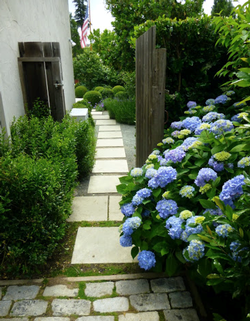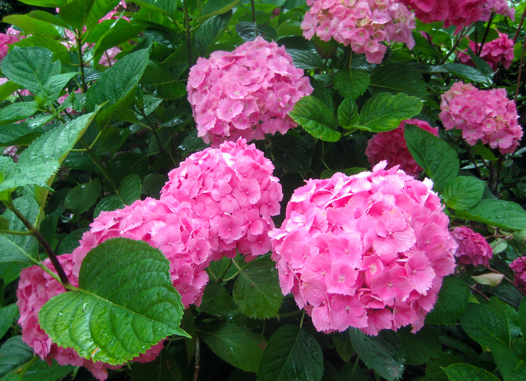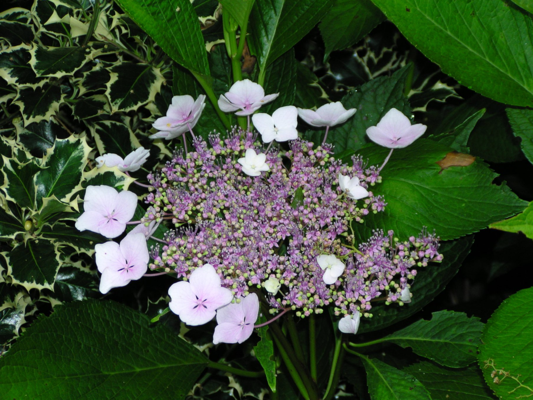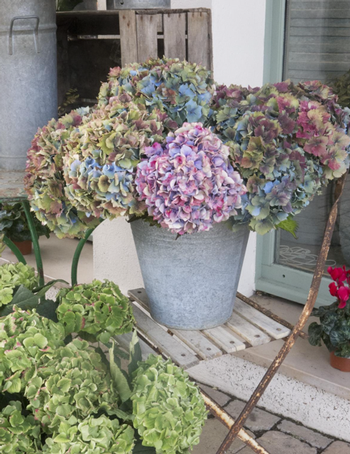Pruning hydrangeas to maximize bloom
-
Hydrangeas come in many varieties, colors, and sizes, and pruning them correctly depends on which species you have. The most common species, especially in older gardens, is Hydrangea macrophylla, a large-leaved shrub with white, pink, red, or blue rounded flower heads. These are the hydrangeas often referred to as “mopheads.”
 Hydrangeas are striking border plants. Photo: Linda Varonin
Hydrangeas are striking border plants. Photo: Linda VaroninA full 98 percent of Hydrangea macrophylla flowers form on old wood -- that is, last year’s branches. These old branches are darker, less pliable, and woodier in appearance. If you prune back this year’s branches, you are effectively eliminating next spring’s flowers. Therefore, it’s best to cut them back just a few buds below the flower. In the spring, after danger of frost, grab your pruning shears and do a final touch-up pruning, being careful to avoid cutting back stems with flower buds. Look at the bush and remove any crisscrossing or very old branches, even back to the base of the plant, in order to thin out the center and shape the plant if it needs it. For bigger flower clusters, remove more branches; for a bigger show of medium-size blooms, keep more branches.
Also in the macrophylla group are the lacecaps, so named for their flat heads, which some say resemble a cap. The center of the lacecap has small, budlike blooms and larger florets around the outside. Mopheads and lacecaps require identical care. Prune two other hydrangea species, H. serrata and H. aspera, as you would Hydrangea macrophylla. Mophead hydrangeas feature large, rounded flower heads in white, pink, red, or blue. Photo: Martha Proctor
Mophead hydrangeas feature large, rounded flower heads in white, pink, red, or blue. Photo: Martha Proctor Lacecap flowers differ from mopheads. Photo: Plantmaster
Lacecap flowers differ from mopheads. Photo: PlantmasterPaniculata cultivars, sometimes referred to as hardy hydrangeas, are extremely easy to grow in common garden soil, are much more drought tolerant than macrophyllas, bloom on new wood, and can be pruned most any time except when the flower heads form in the summer. They are slow to wake from dormancy, but compensate by blooming far into the fall. They can grow quite large -- as tall as eight to ten feet -- but can be kept compact by regular pruning, almost to the ground, in late winter or early spring.
Beware of over-pruning Fresh cut hydrangeas last for months, even years. Photo: Marybeth Kampman
Fresh cut hydrangeas last for months, even years. Photo: Marybeth Kampman
Many hydrangeas have a genetic will to grow to their maximum size, so cutting them back each fall to make them fit a smaller space only reduces or eliminates their capacity to flower. They will first try to grow back to their genetic size and will put all their energy into branches and leaves rather than flowers. It is essential, therefore, to purchase hydrangeas to fit your space. Fortunately, it’s not difficult to find suitable hybrids in all sizes. A quick web search will identify numerous informative sites, particularly of nurseries with illustrated, colorful online catalogs, excellent sources for checking out the various hybrids.Hydrangeas offer big reward for little effort
Hydrangeas perform beautifully with proper pruning and relatively little care. Deciduous, they appear naked in winter, so planting evergreens nearby reduces their bareness. Although hydrangeas are sensitive to too much sun, they prefer at least three hours of morning sun daily, or all-day filtered shade. They also respond well to regular irrigation and a well-balanced fertilizer coupled with compost and a layer of mulch. With the exception of white-flowered varieties, hydrangeas change color depending on the pH of the soil. The more alkaline the soil, the pinker the flowers, and the more acidic the soil, the bluer the flowers. Beware: deer often snack on hydrangea. An added bonus is that hydrangea’s large flower heads (cut when fully dry) will keep indoors for months, even years.Original articles by Julie Monson and Jane Scurich for the Marin IJ.
Edited for the Leaflet by Jane Scurich




